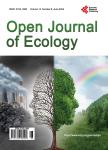Vegetation Structure and Regeneration Status of the Western Escarpment of the Rift Valley of the Gamo Zone, Southern Ethiopia
Vegetation Structure and Regeneration Status of the Western Escarpment of the Rift Valley of the Gamo Zone, Southern Ethiopia作者机构:Biodiversity Conservation and Research Center College of Natural Science Arba Minch University Arba Minch Ethiopia Department of Biology College of Natural Science Arba Minch University Arba Minch Ethiopia Department of Plant Biology & Biodiversity Management College of Natural & Computational Sciences Addis Ababa University Addis Ababa Ethiopia
出 版 物:《Open Journal of Ecology》 (生态学期刊(英文))
年 卷 期:2022年第12卷第1期
页 面:94-111页
主 题:Importance Value Index Regeneration Seedling/Sapling Vegetation Structure
摘 要:Understanding the structure and regeneration of forest resources contributes to identifying the elements of diversity, endemism, threatened and endangered species. This study was conducted in the western escarpment of the Rift valley of the Gamo Zone, Southern Ethiopia. The main objective was to investigate structure and regeneration status of the study area. A systematic sampling method was used to collect vegetation data from a total 102 quadrats, each 20 × 20 m (400 m2) and five 1 × 1 m (1 m2) sub-quadrats were established at the four corners and at the centre for sapling and seedling estimation. Tree and shrub species were listed;Height (H ≥ 1.5 m) and DBH ≥ 2 cm were measured and recorded. R-statically software and Microsoft Excel were used to record and analyse the data. A total of 126 plant species belonging to 43 families and 90 genera were identified. The most dominant families were Fabaceae, followed by Anacardiaceae and Euphorbiaceae. Most frequent species were Euclea divinorum (84.3%), followed by Rhus natalensis (83.3%), Terminalia brownii (74.5%). DBH class ≤ 5cm had highest density (63.6%) and DBH ≥ 25.1 cm had the lowest density (0.87%). Three population patterns have been observed;inverted J, J-shaped and irregular shaped. 93% of species had IVI values b/n 1 - 4, 65% of species IVI values Pappea capensis, Combretum molle, Terminalia brownii, Euclea divinorum had highest IVI values. In the vertical stratification, lower story was 91.3% of the individuals. Only a few species contributed to the high density of saplings (440.2/ha) and seedlings (825.49/ha) while most had very little or no saplings and seedlings at all. Thus, in order to revert the current forest structure and regeneration to the previous natural state, it is considered important to minimize the influence of the human interference, grazing and raising awarene



